Depol Extended
Paracetamol BP 665mg
Depol Extended
Paracetamol BP 665mg
Composition
Product name: Depol Extended.
Strength:Paracetamol 665 mg
Dosage form: Tablet (extended release)
Product description
Paracetamol extended tablet is the preparation of paracetamol 665 mg extended release formulation. It is formulated by dual granulation technology. There are two types of granules in each tablet. 31% (206 mg) is in immediate release form for immediate action and 69% (459 mg) in sustained release form for continuous pain relief for 8 hours.
- AVAILABILITY: AVAILABLE
Pharmacology
Paracetamol has the advantage that it can be administered via the oral, rectal or intravenous routes. At therapeutic concentrations – as a general rule less than 30 mg/L – its binding to plasma proteins is negligible. It is largely catabolized in the liver before being excreted via the kidneys. More than 80% is thus transformed into glucuronide or sulfate-conjugated derivatives. A small proportion (less than 10%) is oxidized by the cytochrome P450 mixed-function oxidase system, producing a reactive intermediate metabolite that is immediately neutralized by reduced glutathione, and then metabolized to form cysteine and mercapturic acid conjugates. Unchanged paracetamol is also found in the urine, representing less than10% of the dose administered
Paracetamol is rapidly absorbed, and peak plasma concentrations (Cmax) are attained 0.5–1.5 hours (tmax) after intake of standard tablets or capsules after fasting. There is a first-passage effect, the significance of which varies according to the dosage or the number of doses, or both. After administration of a single dose, the bioavailability of paracetamol is 0.63 or 0.89, depending on whether the dose ingested was 500 mg or 1g, respectively.
However, at the steady state, obtained after five successive intakes at 6-hour intervals, the bioavailability is identical, whatever the unit dose used, within the range 325 mg to 1g. Up to 18 mg/kg (1 g), paracetamol follows a first-order kinetics (linear) – that is, independent of the dose and constant during repeated administrations with an elimination half-life of about 2–2.5 hours
Paracetamol extend release tablet is a modified-release paracetamol formulation in which each 665 mg tablet contains 69% slow-release and 31% immediate-release paracetamol. There are no data on paracetamol extended release tablet pharmacokinetics in overdose. It is unknown whether the paracetamol treatment nomogram can be used to make decisions regarding the toxicity of this product in overdose.
To compare the pharmacokinetics of Panadol Extend and immediate-release paracetamol in simulated overdose model in healthy volunteers.
Cross-over study using a dose of 90 mg/kg ideal body weight of paracetamol extended release tablet in seven healthy volunteers. Serum paracetamol concentrations were measured over 12 h. Maximal paracetamol concentration (Cmax), time to Cmax (Tmax), area under the curve (AUC) and elimination half-life (t1/2) were compared.
Mean paracetamol dose was 73 mg/kg actual body weight. Panadol Extend produced lower Cmax (0.208 mmol/L +/- 0.02 vs 0.48 mmol/L +/- 0.02, P = 0.0001) and AUC(0-12 h) when compared with APAP-IR. Tmax was delayed with Panadol Extend (2.83 h +/- 0.26 vs 0.94 h +/- 0.17, P = 0.0001). Absorption was complete in all subjects by 4 h post ingestion in both study arms. Elimination t(1/2) was 1.69 +/- 0.09 h for APAP-IR and 1.65 +/- 0.13 h for Panadol Extend (not significant).
Reductions in Panadol Extend Cmax and AUC(0-12 h) might be related to elimination occurring during the absorption phase. In this model of Panadol Extend moderate overdose, Tmax was significantly delayed. In larger overdoses, time to peak paracetamol levels might be further delayed, because of continuing absorption from the formulation. Therefore, the paracetamol treatment nomogram might not reliably predict hepatotoxicity from Panadol Extend if paracetamol levels are measured too early.
Indication
Paracetamol 665 mg extended-release tablet is effective for the relief of persistent pain associated with osteoarthritis and muscle aches and pains such as backache. Paracetamol 665 mg Extended Release tablet also provides effective, temporary relief of pain and discomfort associated with headache, tension headache, period pain, toothache and pain after dental procedures, and cold & flu. It reduces fever.
Dose&administration
Recommended dose: Paracetamol 665 mg.
Paracetamol 665 mg extended-release tablets are to be administered orally, with or without food.
Adults and children over 12 years: Two tablets, swallowed whole, every 6 to 8 hours (maximum of 6 tablets in any 24 hours).
Do not crush or chew extended-release tablets. Doing so can release all of the drug at once, increasing the risk of side effects. Also, do not split the tablets unless they have a score line and your doctor or pharmacist tells you to do so.
Swallow the whole or split tablet without crushing or chewing.
Contraindication
It is contraindicated in patients with hypersensitivity to paracetamol or to any of the excipients.
Warnings and precautions
Paracetamol should be administered with caution to patients with hepatic or renal dysfunction.
Side effects
Reports of adverse reactions are rare. Although the following adverse reactions have been reported, a causal relationship to the administration of paracetamol has been neither confirmed nor refuted: dyspepsia, nausea, allergic and hematological reactions.
Use in pregnancy and lactation
Pregnancy: Category A.
Paracetamol has been taken by a large number of pregnant women and women of childbearing age without any proven increase in the frequency of malformations or other direct or indirect harmful effects on the fetus having been observed.
Lactation:
Though Paracetamol crosses the placenta it causes no harmful effect to breastfed infants or fetuses.
Use in children & adolescents
If you are giving acetaminophen to a child and adolescent, be sure you use a product that is meant for children. Use your child's weight to find the right dose on the product package. If you don't know your child's weight, you can use their age.
Drug interaction
Domperidone & metoclopramide accelerate the absorption of paracetamol.
Colestyramine reduces the absorption of Paracetamol. Prolonged regular use of Paracetamol possibly enhances anticoagulant effect of coumarins.
If you are taking paracetamol (more commonly known as acetaminophen), you should not drink alcohol excessively, as it may react with the drug to damage your liver. Also, avoid cold and allergy medicines that contain paracetamol or acetaminophen, since this may cause an overdose. In addition, certain medicines, such as blood thinners and seizure medications, might cause adverse reactions when taken with paracetamol. Your doctor may suggest that you not breastfeed while taking paracetamol.
Overdose
Paracetamol overdose may cause hepatic failure and in severe poisoning, hepatic failure may progress to encephalopathy, coma and death. In the event of overdose, immediate medical management is required even if symptoms of overdose are not present, e.g. pallor, nausea, vomiting, anorexia & abdominal pain.
Storage
Store in a cool, dry place below 30 °C and protect from light and moisture. Keep out of reach of children.
Packing
Depol Extended Tablet: Box containing 10´10 /20´10/40´10/ 50 ´10 tablets inblister pack
